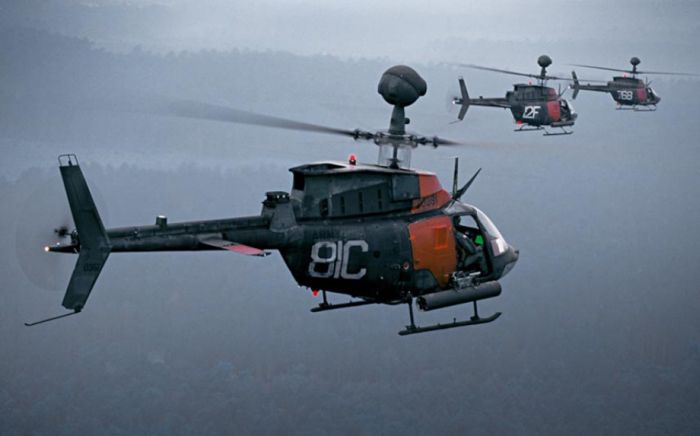|
|
Bell OH-58 Kiowa Military Helicopter
|
On 27 March 1970, an OH-58A Kiowa (s/n 68-16785) was shot down over Vietnam, one of the first OH-58A losses of the war. The pilot, Warrant Officer Ralph Quick, Jr., was flying Lieutenant Colonel Joseph Benoski, Jr. as an artillery spotter. After completing a battle damage assessment for a previous fire mission, the aircraft was damaged by .51 cal (13 mm) machine gun fire and crashed, killing both crew members. Approximately 45 OH-58A helicopters were destroyed in Vietnam due to combat and accidents. One of the last combat losses was of an OH-58A (s/n 68-16888) from A Troop, 3-17th Cavalry, flown by First Lieutenant Thomas Knuckey. On 27 May 1971, Lieutenant Knuckey was also flying a battle damage assessment mission when his aircraft came under machine gun fire and exploded. Knuckey and his observer, Sergeant Philip Taylor, both died in the explosion.
• Operation Prime Chance
In early 1988, it was decided that armed OH-58D (AHIP) helicopters from the 118th Aviation Task Force would be phased in to replace the SEABAT (AH-6/MH-6) teams of Task Force 160th to carry out Operation Prime Chance, the escort of oil tankers during the Iran–Iraq War. On 24 February 1988, two AHIP helicopters reported to the Mobile Sea Base Wimbrown VII, and the helicopter team ("SEABAT" team after their callsign) stationed on the barge returned to the United States. For the next few months, the AHIP helicopters on the Wimbrown VII shared patrol duties with the SEABAT team on the Hercules. Coordination was difficult, but despite frequent requests from TF-160, the SEABAT team on the Hercules was not replaced by an AHIP detachment until June 1988. The OH-58D helicopter crews involved in the operation received deck landing and underwater survival training from the Navy.
In November 1988, the number of OH-58D helicopters that supported Task Force 118 was reduced. However, the aircraft continued to operate from the Navy's Mobile Sea Base Hercules, the frigate Underwood, and the destroyer Conolly. OH-58D operations primarily entailed reconnaissance flights at night, and depending on maintenance requirements and ship scheduling, Army helicopters usually rotated from the mobile sea base and other combatant ships to a land base every seven to fourteen days. On 18 September 1989, an OH-58D crashed during night gunnery practice and sank, but with no loss of personnel. When the Mobile Sea Base Hercules was deactivated in September 1989, all but five OH-58D helicopters redeployed to the continental United States.
|
|









